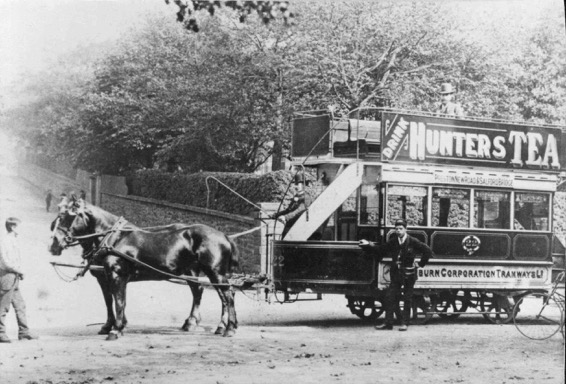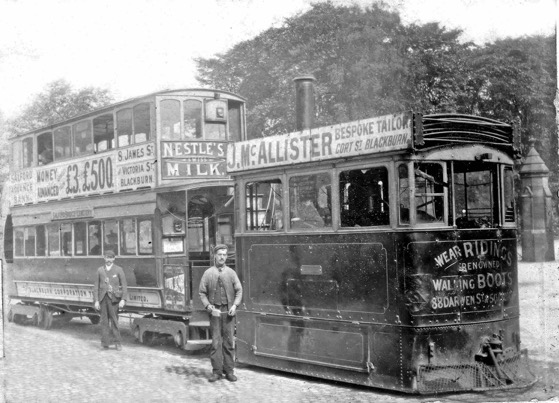Blackburn Corporation Tramways Company Ltd
History
The Blackburn Corporation Tramways Company commenced steam-tram operations on the 28th May 1887 under a lease arrangement with the owners of the track, Blackburn Corporation. The agreement was somewhat unusual in that the corporation owned the track, but it was the company that raised the finance and constructed the tramway, the latter being remunerated in the form of a long-term lease.
The 8.75-mile system was built to a gauge of 4ft 0ins, and comprised lines: northwards to Cemetary; eastwards to Intack and Church; southwestwards to Witton Stocks; and westwards to Billinge End. At Church, the system was connected to another 4ft 0in-gauge steam tramway (that of Accrington Corporation Tramways), however, no through running took place. The tracks of the BCTCo also crossed those of yet another 4ft 0ins-gauge steam tramway (owned by the Blackburn and Over Darwen Tramways Company) — at the junction of Darwen Street and Jubilee Street in Blackburn — though there was no physical connection.
From 25th August 1888 onwards, horse traction was introduced on some lines, a step that was taken at the insistence of the corporation, which did not want steam used on certain lines. The company continued to operate the services for another decade, much of it spent at loggerheads with the corporation, who seem to have had a never-ending list of complaints about speeding, general safety and violation of emissions legislation (somewhat ironic given that Blackburn was a coal-powered mill town).
Overall, the company was relatively successful, even though hampered by the corporation's perverse insistence on the use of loss-making horse traction (on some lines), meaning that the profitable steam services were effectively used to subsidise a form of transport that they were intended to make obsolete.
By the late 1890s, the corporation was keen to take over of the system, convert it to electric traction, and then operate it municipally. This however, meant buying the BCTCo out of its lease, which did not end until 1908, the corporation inevitably having to pay a premium. In spite of this, a deal was duly reached, and the corporation took possession on the 24th August 1898, operating the system until it had been fully converted to electric traction, a process that would take it the best part of three years to achieve. The last steam service is thought to have run on the 8th July 1901.
Uniforms
Only a single photograph has survived depicting the company's horse trams, and unfortunately, it gives few clues as to the date it was taken. What it does however show is that drivers wore informal but smart attire, comprising jacket, shirt and tie, along with the ubiquitous bowler hat, a particular favourite of Victorian coachmen. Conductors also appear to have worn informal jackets, but with soft-topped peaked caps that were possibly provided by the company, given that they appear to have borne a metal badge (of unknown pattern). If a cap badge was indeed worn, and the photo is far from definitive, then it was possibly only for a very short period, as all surviving photographs of steam-tram conductors, which are numerous, show no evidence of a cap badge.
In common with the vast majority of steam-tramway operators in the British Isles, drivers wore railway footplate-like attire such as cotton jackets and trousers, along with soft-topped or grease-topped peaked caps; neither the jackets nor the caps carried badges or insignia of any kind. Conductors wore informal attire, comprising: jacket, shirt and tie, along with that late-Victorian favourite, the flat cap. Most photos however, date from the second half of the 1890s, so there remains a possibility that caps were worn in the early years, but this has escaped the photographic record.
At some point, municipal licence badges, both drivers and conductors wearing these when on duty; the badges, which were round, were suspended by means of a leather hanger from the jacket or some other item of uniform paraphernalia, such as a cash-bag strap.
It is currently unclear what uniforms were worn by senior staff such as inspectors, or indeed, whether the BCTCo even employed their services.
Further reading
For a detailed history of the company, see: 'A History of the British Steam Tram — Volume 2' by David Gladwin; Adam Gordon Publishing (2006).
Images
Horse tram drivers and conductors
The driver and conductor of Horsecar No 22 pose for the cameramen at the Billinge terminus of the Preston Road horse tram route — photo undated, but probably taken in the early 1890s given the pristine condition of the vehicle. Photo courtesy of Duncan Holden.
An enlargement of the above photograph showing the driver (in tall bowler hat) and the conductor (holding the dash rail). The latter is wearing a single-breasted jacket (probably informal) and a soft-topped peaked cap that appears to bear a reflective, and therefore metal cap badge; unfortunately, no examples are known to have survived, so details of what the badge bore remain unknown.
Steam tram drivers and conductors
A driver (with oil can in hand) and a conductor pose for the cameraman at the Cemetery terminus with Thomas Green-built Steam Tram No 3 and Trailer No 4 (both of 1887)— photo taken in 1896. Photo courtesy of Duncan Holden.
An enlargement of the above photograph showing the driver and the conductor. The former is wearing typical footplate clothing befitting the filthy nature of his work; the conductor is wearing informal attire, including a flat cap. What at first glance would appear to be a licence (on his cash-bag strap) is probably a round ticket punch.
The driver and conductor of Steam Tram No 11 and Trailer No 13 captured for posterity in Water Street, the town centre terminus of the Cemetery route — photo taken in 1897. Photo courtesy of Phil Calvey.
An enlargement of the above photograph showing the conductor, who is wearing clogs and a round licence, the latter hung from his cash-bag strap. The licence badges may possible have been of the same enamel pattern (white lettering on a blue background) later issued to electric-tramcar crews (see link).
Another blow-up of the above photograph, this time showing the driver; he is clearly wearing a round licence.
An unidentified Thomas Green-built steam engine and Trailer No 4, again taken at the Cemetery terminus, purportedly around 1892, though given the battered state of the engine (built in 1887), it is possibly very much later than this. Photo courtesy of Duncan Holden.
A driver and conductor with Thomas Green-built No 10 and Trailer No 16 at the Cemetery, clearly a favoured photographic location — photo taken around 1898. Photo courtesy of Duncan Holden.